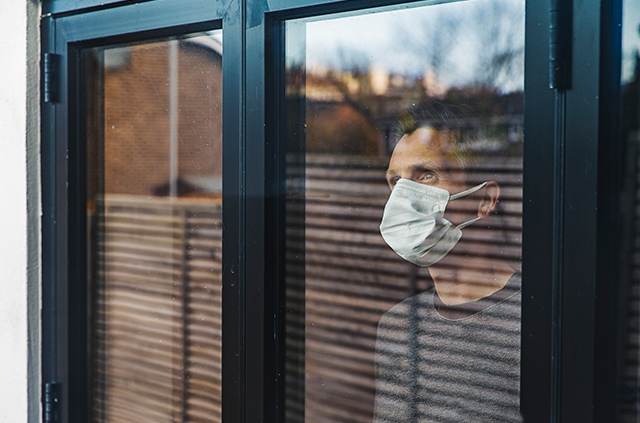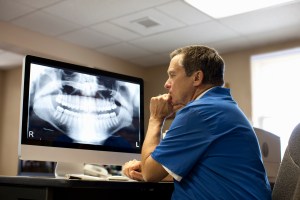March 11, 2020 marked the day the World Health Organization officially declared COVID-19 a global pandemic. By April 2020, up to half of all working Americans were telecommuting. Remote work helped slow the spread of COVID-19 by allowing for quarantining, social distancing and lessening the amount of people using public transportation and inhabiting office buildings.
Fast forward to April 2021, and many people are still working from home. While WFH has its own list of pros and cons, anxiety brought on by the pandemic has had significant negative effects on our physical and mental health.
“On the plus side, workers tend to prefer working from home, it reduces emissions and office costs and it helps people (especially women) balance work and family roles. It may even make us more productive,” according to The Brookings Institute. “The downsides: managing a telecommuting staff can be difficult, professional isolation can have negative effects on well-being and career development and the effects on productivity over the long run and in a scaled-up system are uncertain.”
Learn how the pandemic and working from home have affected your wellbeing with this review of 2020’s biggest stressors.
The Effects on Mental Heath
The pandemic affected nearly every aspect of life. Fear over family, friends and your own risk of catching the virus as well as worrying about potential job loss, your children’s education, the economy and if/when things would ever get back to “normal” were all major stressors.
People were so stressed over the pandemic, it even led to a spike in COVID-19 dreams, or nightmares related to the pandemic.
Isolation
Foregoing social interactions to protect yourself and your community was necessary, but a lot of people felt stuck at home during quarantine. The inability to physically be with friends and family, go to work or attend social hubs like bars, restaurants and theaters led to feeling of loneliness, helplessness and boredom.
“Preliminary surveys suggest that within the first month of COVID-19, loneliness increased by 20 to 30%, and emotional distress tripled,” according to Health Affairs.
Anxiety and Depression
“During the pandemic, about four in 10 adults in the U.S. have reported symptoms of anxiety or depressive disorder,” according to the Kaiser Family Foundation (KFF), compared to one in 10 adults in 2019.
This was especially true for essential workers, who were at higher risk of contracting the virus.
“Compared to nonessential workers, essential workers are more likely to report symptoms of anxiety or depressive disorder (42% vs. 30%), starting or increasing substance use (25% vs. 11%), and suicidal thoughts (22% vs. 8%) during the pandemic,” according to the KFF.
Binge and Panic Buying
We all remember seeing empty shelves at the grocery store, either in person or on the news. The pandemic brought on an explosion of panic buying, where consumers sprung for everything from paper products and cleaning supplies to canned goods, hand sanitizer and entertainment devices as a way to cope with fears of the virus. Limits had to be put on certain goods – like Lysol wipes and toilet paper – to ensure there was enough to go around.
Digital Burnout
The sudden transition to WFH was a stress for some. Difficulty with the separation of work and personal time – or failure to establish a healthy work-life balance – led to many at-home workers experiencing burnout, an official “occupational phenomenon” recognized by the WHO.
Symptoms include “feelings of energy depletion or exhaustion, increased mental distance from one’s job or feelings of negativism or cynicism related to one’s job and reduced professional efficacy,” according to the WHO.
Email Anxiety
Telecommuting also means relying more on digital communication, and more emails by proxy. Racking up too many unread emails, the fear of potentially missing something important or looking like you’re slacking are all major stressors.
Emails are often the first thing people check when they wake up, and whether it’s someone else not responding to you or not knowing how to start or answer an email, email anxiety has only increased with WFH.
Video Chat Stress
Many people feel self-conscious showing their face on camera, but researchers have suggested video calls can actually trigger your fight-or-flight response as well.
“Zoom, Google Hangouts, FaceTime, Skype and other video conferencing tools display a full-screen image of the person talking by default, making them appear closer than might normally be socially acceptable during in-person meetings,” according to Business Insider.
COVID Fatigue
Exhaustion caused by all the worry and change brought on by the pandemic and/or feelings of being cooped up for too long led to COVID fatigue toward the end on 2020 and start of 2021. This type of burnout caused some people to be less cautious about following restrictions, potentially contributing to spikes in cases.

The Effects on Physical Health
Whether or not you contracted the coronavirus, the pandemic probably impacted your physical health in some way. From changes in weight and energy levels to the worsening of chronic conditions, we’ll likely be dealing with the repercussions of 2020 for years to come.
Increased Substance Use
Loneliness, anxiety and other negative feelings brought on by the pandemic led to increased use and abuse of tobacco, alcohol and other substances.
“Alcohol sales in stores were up 54% in late March compared to that time last year, while online sales were up nearly 500% in late April,” according to the American Heart Association. Also, according to a “poll of 2,200 U.S. adults conducted in early April, 16% of all adults said they were drinking more during the pandemic, with higher rates among younger adults: One in 4 Millennials and nearly 1 in 5 Gen Xers said they had upped their alcohol intake.”
Less Physical Activity
Sitting in front of the computer, streaming more entertainment, getting lost scrolling (or “doomscrolling”) through your phone and only leaving the house for essentials meant less physical activity for many Americans.
Exercise can help you sleep better, strengthen your immune system and improve your mood. The opposite could be argued for exercising less.
Weight Gain
Less physical activity paired with eating and drinking more due to stress resulted in many Americans experiencing noticeable weight gain. “Pandemic weight” or “quarantine 19” – a play on the idea of freshman 15 – were phrases floating around on social media.
61% of U.S. adults reported undesired weight change since the start of the pandemic, according to the American Psychological Association.
Skipping Checkups
Fear of contracting COVID and/or exhausting an already overwhelmed healthcare system meant fewer people went for doctor’s visits, dentist appointments and other health-related consultations.
“Emerging evidence tells us that the health threats from postponing some tests and exams – including those for cancer and heart disease, but other crucial appointments too – outweigh the risk of running into the coronavirus at a doctor’s visit,” according to NPR.
Long Haulers
If you were one of the 29+ million Americans who contracted COVID-19, you could be experiencing lingering symptoms weeks, months and potentially indefinitely, even after the virus has left your system. Post-COVID-19 syndrome, also known as “long COVID-19” or “long haulers,” is still being studied, but several symptoms have been identified.
“The most common symptoms are fatigue, body aches, shortness of breath, difficulty concentrating, inability to exercise, headache and difficulty sleeping,” according to Harvard Health Publishing. Other long-term symptoms include joint pain, loss of smell or taste, a cough, fast or pounding heartbeat, chest pain, rash or hair loss, according to the Mayo Clinic.
What’s the Good News?
There are reasons to be optimistic. The rollout of vaccines has offered hope that a new normal is possible. Also, the changing of the seasons means more people will be able to leave the house to get some fresh air, sunshine and exercise – like biking, hiking, running and walking.
We’re also still learning as we go. More and more institutions are recognizing the impacts of the pandemic on our mental health, offering coping techniques and more flexible work environments (paid time off to get vaccinated, continued remote work and/or hybrid schedules, etc.) to help people readjust.
Research on the coronavirus, vaccinations and long haulers is still ongoing. Fully vaccinated individuals can now gather with other fully vaccinated individuals, making much-needed social interactions a safer option.
Just remember, vaccinated or not, we should all still be following CDC guidelines by wearing masks in public, maintaining six feet of distance and frequently washing our hands.
“We’re still learning how effective the vaccines are against variants of the virus that causes COVID-19,” according to the CDC. “Early data show the vaccines may work against some variants but could be less effective against others.”
For more information on how stress impacts your health and coping techniques, see here. Also check out ways to help your kids deal with school stress, how COVID anxiety can affect your driving and this list of items to help you relax.
What stressors have you dealt with during the pandemic? How have you coped? Tell us in the comments.
4 Thoughts on “Pandemic Habits: How Life-Altering Changes Impact Our Health”
Leave A Comment
Comments are subject to moderation and may or may not be published at the editor’s discretion. Only comments that are relevant to the article and add value to the Your AAA community will be considered. Comments may be edited for clarity and length.












After being extremely careful this last year, I became sick and tested positive last week for Covid. I am in quarantine. Going into week 2 since being tested. I had my first vaccine 10 day prior to getting sick. Live alone. Really tired of the whole thing. Confused by the conflicting guidelines.
Hello, D. I’m sorry to hear about testing positive. I hope your symptoms are very mild and that you recover quickly.
Thank you for reading and commenting.
Since wearing a mask every day all day long my Asthma symptoms have tripled. I went from so mild that I didn’t believe I had it to needing an inhaler to go up a full flights of stairs.
Hello, Linda. I’m sorry to hear about your worsening asthma symptoms. This resource from the Asthma and Allergy Foundation of America suggests trying a mask with a different fabric or fit. I hope this helps.
Thanks for reading and commenting.